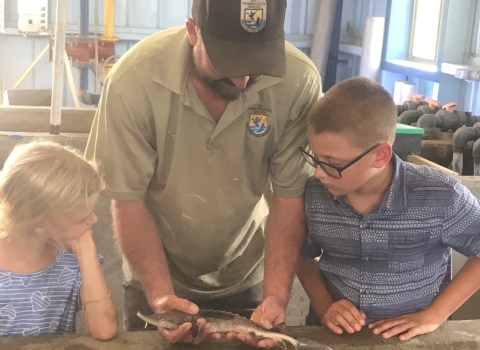Do lake sturgeon belong in the state of North Carolina? Sure they do! Edenton National Fish Hatchery has been part of the Lake Sturgeon Restoration Program for eight years now. While the main focus of this multi-agency restoration program is on the upper Tennessee River, from 2014 – 2021 the majority of Edenton’s fish have been stocked into the lower French Broad River in Marshall, North Carolina. The French Broad is the third oldest river in the world! It flows for 218 miles, starting in North Carolina and ending in Tennessee where its confluence with the Holston River in Knoxville forms the beginning of the Tennessee River. These fish were once plentiful in the lower French Broad; however, the North Carolina lake sturgeon population was wiped out in the mid-20th century.
Since 2014, in cooperation with North Carolina Wildlife Resources Commission (NCWRC), Edenton National Fish Hatchery staff have stocked a total of 35,371 lake sturgeon. Hatchery staff released 20,346 into the lower French Broad of North Carolina. That is nearly 58% of what the hatchery has raised! The remaining 15,025 fish were distributed in Tennessee rivers. NCWRC recently started surveying to determine if what is being done is enough. There are some reports of anglers catching lake sturgeon!
This year Edenton received around 6,000 lake sturgeon fry from Warm Springs National Fish Hatchery. These fish had a grow-out period from late May to early October. When sturgeon reached a minimum length of 5.5” they were marked by removing the 7th and 8th scute (a boney plate) on their left side. On September 29th, 1,802 lake sturgeon were distributed to the French Broad in Marshall, NC and the remaining 1,559 sturgeon were stocked in the same place on October 5th.





